Check out SoFoBoMo. I like the concept of a "fuzzy month."
____________________
Mike (Thanks to Gordon)
« December 2007 | Main | February 2008 »
Check out SoFoBoMo. I like the concept of a "fuzzy month."
____________________
Mike (Thanks to Gordon)
Posted on Sunday, 20 January 2008 at 01:05 PM | Permalink | Comments (2) | TrackBack (0)
Things get quiet enough to hear crickets chirping on Saturday nights—that is, if there were any crickets in this kind of weather. Zander was off to the high school at a "battle of the high school bands" sort of thing ("The Dean" and "Son of Chuck" were the best, according to Z., and neither placed in the top three), and since it's –8°F outside, Lulu and I aren't going any place. I ended up watching not one but two John Cusack movies on TV. So I suppose it's as good a time as any to announce that I've started a companion website to this one, called Photoborg.org.
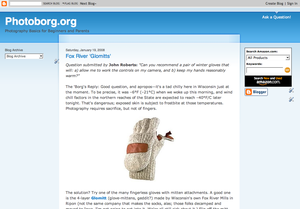 I don't imagine that Photoborg.org will be of urgent and undying interest to T.O.P. readers. It's meant to be a counterpart and a complement to this site—it's for people such as first-time camera buyers, new parents, pet owners, scrapbookers, and kids. The format will be mostly question-and- answer. To begin with, I answered a question that regular T.O.P. reader John Roberts asked in the comments to the "Half Life" post below, about how to keep your hands warm and still be able to work the camera when you're out in the cold. Seemed appropriate.
I don't imagine that Photoborg.org will be of urgent and undying interest to T.O.P. readers. It's meant to be a counterpart and a complement to this site—it's for people such as first-time camera buyers, new parents, pet owners, scrapbookers, and kids. The format will be mostly question-and- answer. To begin with, I answered a question that regular T.O.P. reader John Roberts asked in the comments to the "Half Life" post below, about how to keep your hands warm and still be able to work the camera when you're out in the cold. Seemed appropriate.
At best, I hope it turns into a place where you will be comfortable referring beginner friends and relatives.
I got the idea for Photoborg.org when I spoke to an old acquaintance over the holidays. He said he looked at T.O.P. every now and then, but that it was generally "too deep" for him. —And he was doing work as a professional photographer at the time! Well, so maybe it will do some good to have a more basic site. I didn't want to dilute T.O.P. by trying to cover basics here, though. T.O.P. won't change.
So anyway, anybody got any questions?
And please, tell your friends, tell your countrymen. If you'd like to take a look, you should be able to get there by typing "photoborg.org" in your address bar.
And thanks to John Roberts for his question.
________________________
Mike
Posted on Sunday, 20 January 2008 at 12:47 PM | Permalink | Comments (20) | TrackBack (0)
By Ctein
The new MacBook Air is not a substitute for a MacBook Pro. Steve says as much, and if he didn't the pricing would tell you so. They both cost about the same. The Pro is undeniably the more powerful and expandable system, so should photographers even care about the Air?
Maybe, just maybe.
Surprisingly, the MacBook Air is not a lot smaller than a 15 in. MacBook Pro. The Pro is only an inch longer. The Air is only 25% thinner, coming in at three-quarters of an inch instead of one. It's startling how much difference that makes; if I had hazarded a guess before I measured it, I would've said the Air was only half as thick. The big difference is in the weight: the Air weighs only a bit more than half as much, coming in at three pounds.
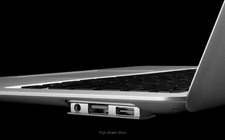 Apple discarded a lot to slim the machine by that much. No optical drive, no Firewire or Ethernet ports, and no expandability. The I/O limitations could be a problem. You can get USB to Ethernet and Firewire adapters (although the latter are rare and costly). You get 2 GB of RAM, an 80 GB hard drive, a built-in battery, and you better like it. You can plug in an external monitor, which is cool. You can also plug in an external optical drive, which isn't really. I've owned compact laptops which had external peripherals. It's a pain hauling them around. It's a lot more convenient having everything built into a larger machine.
Apple discarded a lot to slim the machine by that much. No optical drive, no Firewire or Ethernet ports, and no expandability. The I/O limitations could be a problem. You can get USB to Ethernet and Firewire adapters (although the latter are rare and costly). You get 2 GB of RAM, an 80 GB hard drive, a built-in battery, and you better like it. You can plug in an external monitor, which is cool. You can also plug in an external optical drive, which isn't really. I've owned compact laptops which had external peripherals. It's a pain hauling them around. It's a lot more convenient having everything built into a larger machine.
On the plus side, the machine is incredibly wireless-savvy. It can communicate wirelessly with another Mac or PC and use that machine's optical drive. The LED screen is bright enough to be readable in direct sunlight (although I'd rather not). The keyboard feels great.
So why might you care?
For start, when you're traveling, the RAM and hard drive are entirely sufficient. 2 GB RAM is enough to work on pretty large images in Photoshop efficiently; few of us own such high-end digital cameras that we'll be taxing the system resources. After installing the OS and all your primary applications, you're still going to have a good 50 GB of hard disk space free for images.
Two reasons why a photographer might go for this, both of which have photographic analogies:
• The camera that makes the best photographs is the one you have with you. The fancy camera that you left at home because it was too big or inconvenient to use doesn't make very good photographs at all.
• No professional photographer would ever think of going on assignment without a backup camera body. No smart amateur going on expensive trip would, either. Camera failures are rare, but they can ruin your assignment/vacation photography.
How important is having a computer with you when you go off to to make digital photographs? Think about the possibility the MacBook Air is like that second camera body or the camera you take with you because it's small and light enough to not be a bother.
I'm not running to buy one. But you might have good reason to be.
___________________________
Ctein
Photos courtesy of Apple, Inc.
Featured Comment by Herman Krieger: "And there is the OLPC (One Laptop per Child) with a built in camera."
Featured Comment by John Camp: "I just spent a couple of weeks dragging a 15" MacBook Pro around Iraq, and I definitely need a lighter laptop. With a D3, three lenses, the usual accessory bits, a sat phone and a couple of books, I could barely pick up the pack. One way Apple has reduced weight in a fake way is to move the power supply off-board. I don't see any change on this one, so I'm assuming (incorrectly?) that you'll still have that fat white power supply to haul along with you. There's another half-pound or so that they don't count.... What I really need is simply a small 12-inch MacBook Pro. I could finesse the optical drive, but need battery access.
"I'd make some changes—like more USB ports, and dedicated CF and SD ports would be great. Shrink the power supply.
"I think the problem is that Jobs thought he learned a great lesson with the iPod and the iPhone, which is that flash counts more than function. It does, to an extent, in certain products, but function becomes more important when there's more cash on the line. They produced a flashy computer with the Air, but it's short of function. What they really needed to do was sit down with engineers and figure out the best possible travel computer—what do real working travelers need, when they're Mac users? They didn't do that; they went for cool-on-the-beach. My personal feeling is that possession of a Mac, alone, won't pick up that many chicks. Of course, I could be wrong...."
Posted on Friday, 18 January 2008 at 06:37 AM in Ctein | Permalink | Comments (41) | TrackBack (0)
I realized recently that I bought my big ol' Gitzo Studex tripod when I was 23, from old Mr. Baker at Baker Photo on Wisconsin Avenue in Washington, D.C. (Tenley Heights, I think the area was called. It's been a long time.*) Actually I traded him for it—traded the Konica Varifocal ur-zoom that I've written about as being the genesis of my lifelong dislike of zooms. I remember he disappeared into the basement for a good long time to see if he could find one of them that he thought he already had. He came back empty-handed, which made him more interested in mine. The lens was already outdated, just, but Mr. Baker really liked them and had a soft spot for them (they were certainly big, impressive pieces of glass). I think he had a soft spot for young photographers, too—his wife used to complain that he was always giving deals to ardent beginners that weren't good for the bottom line. I was nothing if not bitten by the bug. I think that Konica lens for the big Gitzo was a steal.
Anyway, I'm 50 now, so that was 27 years ago. And, by coincidence, my life expectancy at the moment is 27 more years. The Gitzo is a little the worse for wear—it's lost one of the little rubber collars for the locking knobs, and the gunmetal steel legs have a smattering of chips in the finish. But it works fine. I really see no reason why it shouldn't continue working for another 27 years just as well as it has for the last 27. So what should I say when anyone asks me how long I've had the good old Gitzo? Half my life? Half of its life? I think it's a good bet that we'll go out together. Although it might have some more life left by the time it becomes an orphan; I'm likely to be less hard on it in the second half of our acquaintance than I was during the first half. But that still might not save it. People tend not to care so much for beat-up pieces of equipment unless it was they themselves who did the beating up. Guess I'd better "use it up," then.
_______________________
Mike
*Tenleytown, near Friendship Heights. Thanks, Dan.
Featured Comment by Clay: "It's funny how some things just are better than than they seem like they ought to be. My example is a day pack I bought back in the mid seventies—I was ( and still am to a degree) a mountain climber, and I succumbed to European romanticism and bought this gray canvas Sac Millet day pack from REI. I got it in the mail, and my immediate thought was: 'what a piece of crap.' It just seemed cheesy and poorly made.
"So I decided, what the hell, I will just try to destroy it. Well, it traveled with me on many crazy climbing trips and later on, as a picnic carrier for hikes with my kids. We just moved recently, and I unpacked a box, and there it was, with a nice patina from the abuse I threw at it, but still fully functional and ready to go. I never expected this thing to last more than a season. But it has been dragged up tens of thousands of feet of granite at the end of a rope, dropped five hundred feet on one occasion, and it has never needed to be repaired. I think that is pretty cool. I expect that I will give this to a grand kid some day who wants an uber-cool vintage book bag for college."
Posted on Friday, 18 January 2008 at 06:23 AM | Permalink | Comments (25) | TrackBack (0)
Our uncelebrated Paparazzi
"They call Jude Law Celebrity Dave, because his first name is really
David and because he is fond of declaring, 'I am not a celebrity. I am
an ac-tor.' Yeah, right, they all laugh. 'So I tell him,' one says, 'same here, mate. I'm not a pap. I am a phot-o-graph-er.'
"The paps refer to the stars by their first names—Kate, Amy, Kylie—as if mentioning friends, but it is a strangely alienated kind of intimacy for, unlike the consumers of their wares, they feel little curiosity about them. Affections and animosities are entirely commercial; everyone loves Kylie because she always 'gives up,' meaning she pauses on her doorstep and smiles, and everyone hates Sienna, because she shouts abuse and ducks. Much as traffic wardens wonder why motorists take tickets personally, the paps seem bemused that Sienna should hate them, when they are only playing their part in the publicity food chain off which she, too, feeds. Everyone—paps, editors, press agents, doormen—refers to the business as 'the game'; the rules of the game, playing the game, the name of the game...."
(From "Reaching for the stars" by Decca Aitkenhead, in The Guardian)
-
Reviews We Never Finished Reading, Dept.
"I'm one of those who believe that absolute knowledge is unattainable
and that judgments must be continually questioned in order to attain
relative certainty...." [First line of a review of a consumer electronic component]
-
Check out the work of Luca Prasso. He also has a site called DiLuna with Nadia Andreini, featuring the work they do for non-governmental organizations.
-
But he didn't sign himself 'Mr. Irony'
[Political website comment] "I don't think we Americans are nice people any more. We used to be nice people. We're not that nice any more."
[Response in the thread] "I am sick of a--holes like you who run America down. If you don't have anything half way intelligent to say then shut the f--- up."
-
Fourteen of my 15 minutes
What can I say? It's my
"Moonlight Sonata," my "Rock the Casbah" (or my "Copacabana")—The Post
That Won't Die. It's recently been translated into Polish. The original still draws traffic. (Wish I could write another one as popular.)
-
Epiphany
Maybe people really do enjoy using Leicas more than other cameras.
-
Someday, he may not have photographers to kick around any more
Down, you despicable cur. I'm busy praying for brotherly love.
-
Printer expert Vincent Oliver pinned down
Which printer is best? "Rarely will I give a straight answer, just because everyone has their
own personal taste when it comes to colour etc. But here is my shopping
list of what I think are the top 10 printers, in order of preference—of course." (It's at the bottom of the page.)
-
Cold comfort
Number of questions the major TV networks have asked the leading presidential candidates in the last year, ending yesterday, according to MoveOn.org: 2,679
Number that were about global warming: 3
Number that were about UFOs: 3
-
David Plowden on Studio 360
A lovely interview with David Plowden from Studio 360. Longish, but a very pleasant listen.
________________________
Mike (Thanks to "John," Tomasz, John Willard, Andrew Smith, Bob Peterson, and Edd Fuller)
Posted on Wednesday, 16 January 2008 at 08:14 AM | Permalink | Comments (9) | TrackBack (0)
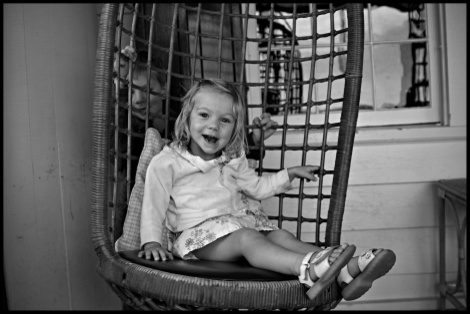
Teddy and Charlotte, brother and sister and my first cousins once removed. I like photographing people, but only when I have permission, implicit or explicit.
The previous posts reminds me of the story of the day I discovered I'm not a photojournalist. As an impoverished art student in the 1980s (before I became a powerful internet mogul, that is), I used to walk around D.C. with my camera strung around my neck. I was supposed to, which I loved. It was my "job" to out be taking pictures for school, so naturally I spent a lot of time doing just that. I had only one lens for my little Contax, a 35mm ƒ/2.8 Distagon, and I knew my lens and my camera like it was part of me. I could take pictures without thinking. Naturally I knew exactly what the lens "saw," that is, how much it took in—I didn't need to look through it to know what would be in any picture.

Me, showing Charlotte one of the pictures I'd just taken of her. Photograph by my brother, Charlie, who has a whole archive of pictures of me taking pictures.
Maya Ying Lin's Viet Nam War Memorial was new at the time, and had been controversial. Lots of people at first felt it wasn't sufficiently monumental, or not sufficiently figurative, or just too "arty." Then, gradually, in what is almost a vindication story of the power of real art, people began to discover the Wall's surprising potential for great emotional impact. It was a place where veterans gathered, families came to see names, and friends came to visit the names of missing friends—or simply where people went to reflect on life and death and war and peace. People left notes and mementos, which I believe the Park Service respectfully collects and archives. It's just a surprisingly moving place. I visited it occasionally with my camera, in the course of my peregrinations around Washington.
Then, one day, one of those magical moment happened. It was the middle of a weekday and there were almost no people at the Wall. But as I entered from one end I became aware of a milling group ahead in the middle distance. A man was setting up a camera on a tripod. As I watched, an elderly gentleman was helped out of his wheelchair and walked to the Wall in the company of his wife. While this happened, the rest of what must have been a large extended family lined up to watch, in a big semi-circle. Many of them were crying, or had their hands to their mouths. As I watched, the two elderly people raised their hands and pointed to one name, obviously that of a dead son, and the man at the camera bent down to take their picture.
It was just one of those moments when the world resolves itself perfectly. The whole family had been on the far side of the man with the camera, so no one was standing in my way; and I was standing at the perfect distance for my lens to take in the whole scene—the Wall, the family, the two old people pointing, the empty wheelchair, the man bending down to record the moment; everything was presented to the camera as perfectly as if I had hired actors and staged it. It told a complete story. And I was in just the right position. I still feel that if I merely raised my camera and took just one shot, it would have run on the front page of the Washington Post the next day.
But I didn't take the picture. It just seemed wrong, somehow. I had stopped walking toward the group, and stood there waiting, out of that reflexive sense of politeness we all feel in not wanting to intrude on others. To start snapping pictures of the whole group of strangers seemed to me like it would have been presumptuous. It just felt to me like it wasn't my moment, is all. It was their moment, a private family moment, that just happened to be taking place out in public because that's where the Wall was.
The picture that arranged itself in front of me disappeared as quickly as it had appeared. The man took his record shot, the father was helped back to his wheelchair, the family which had lined up so perfectly atomized into smaller groups. The moment was gone, except from my memory. Too late, by then, to reconsider.
I admit that in years since, I've regretted my reaction. I do wish I'd taken that picture. But that was definitely the day that my ambitions to be a photojournalist ended. There are some things we are and some things we aren't; I'll never sky-dive, or do a bad audition on American Idol just to get on TV. It's just not who I am. And whatever else it does or doesn't take, photojournalism requires a burning drive to get the shot—you need to have a certain boldness, a higher loyalty to getting the picture than to acting with the utmost civility. It's just the name of that game. In the pinch, in the heat of that moment, when I was presented with maybe a 30-second window when I had to choose whether to shoot or act respectfully, it was more important for me to be respectful of that family's privacy. I didn't really plan it, and I can't really take it back. It's just who I am, I guess.
We never talk about these things—it's so much easier to discuss the corner resolution of a DSLR, and other things that really matter very, very little. But these are much more important issues, of course. A classmate of mine in school was obsessed with still life; I asked her about it once, and she said, "I'm shy with people, so I can't photograph them. Photographing objects is what's open to me." We all photograph not only the subjects that interest us, in the situations we find compelling, but also, we photograph in situations we happen to find comfortable to photograph, and amenable to whatever our personalities happen to be. And that's a matter of psychology, as much as art.
_____________________
Mike
Posted on Monday, 14 January 2008 at 06:32 PM | Permalink | Comments (51) | TrackBack (0)
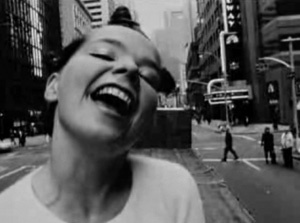 In a reprise of her attack on a journalist in a Bangkok airport in 1996, the brilliant but mercurial Bjork wordlessly attacked Glenn Jeffrey, a photographer with The New Zealand Herald, yesterday in Auckland. He had apparently ignored requests from Bjork's companion to stop shooting pictures.
In a reprise of her attack on a journalist in a Bangkok airport in 1996, the brilliant but mercurial Bjork wordlessly attacked Glenn Jeffrey, a photographer with The New Zealand Herald, yesterday in Auckland. He had apparently ignored requests from Bjork's companion to stop shooting pictures.
"I took a couple of pictures and I got about three or four frames of her," Jeffrey said, "and as I turned and walked away she came up behind me, grabbed the back of my black skivvy [sweatshirt] and tore it down the back. As she did this she fell over, she fell to the ground. At no stage did I touch her or speak with her."
Naturally, police declined to investigate or press charges, in accordance with international "celebrities can do whatever the hell they want" laws.
Extra credit: Identify the portion of the story above that shows I am not a real journalist.
_______________________
Mike
Posted on Monday, 14 January 2008 at 09:43 AM | Permalink | Comments (36) | TrackBack (0)
It's really a lot of fun when your city's (or, in our case, state's) sports team does well. This weekend the cards continued to fall our way—not only are the Packers going to the NFC Championship Game, but the game will be held in Green Bay, for only the third time ever. Brett Favre has been the Green Bay quarterback for as long as I've been in the Midwest, longer than my teenage son has been alive—there are teams in the NFL who have required the services of as many a twenty quarterbacks during the time that Brett has been starting for Green Bay every week, season after season. This season has rather improbably been one of his best, with records falling like dominoes nearly every week—most points by a quarterback, most victories by a quarterback, most touchdowns. Yesterday they set a few franchise records—most points in a playoff game and most yards by a running back (not bad for a team that started the year with no running game).
So what did Brett talk about? The snow. Believe it or not, it was the first time he's ever played a game in Wisconsin in a snowstorm. "Yeah, that was awesome." he said afterwards. "I've been hoping for that for seventeen years. I watched the weather all day. I'm like, 'just give us one of those big snow games'...I wanted to play where you couldn't see the field and the snow plow comes out, and it just kept getting worse and worse. It's amazing, I've played a long time up here and that's the first time it snowed like that."
_____________________
Mike
Posted on Monday, 14 January 2008 at 08:02 AM | Permalink | Comments (16) | TrackBack (0)
By Ctein
This is my 50th (golden anniversary) T.O.P. post, so let's discuss the source of gold:
Public Relations!
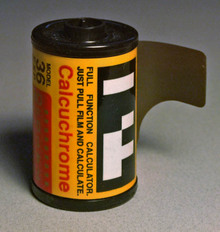 PR is the way that companies get the press to notice them. All PR gets you noticed. But some PR won't get you noticed in the way you want!
PR is the way that companies get the press to notice them. All PR gets you noticed. But some PR won't get you noticed in the way you want!
PR doesn't have to be expensive. The photographs here show a bit of PR from a certain film manufacturer (guess who) a dozen years back. A working four-function calculator built into a film canister: the original "digital film!" The film's a membrane keypad; you squeeze the symbols to enter them. It works faster than you'd think. Those things cost about as much to the company as a single mailed press release did, and the press loved them.
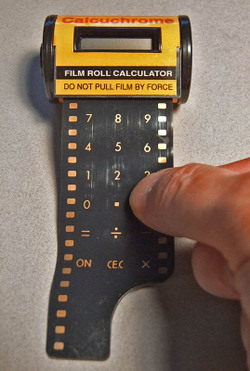 Mine finally died, so I took apart for your benefit and to see what I could do. The dead battery was easy. The partially disconnected ribbon connector to the LCD display, unfortunately, is probably beyond my skills to repair. I'm going to show it to a genius friend of mine just in case he may be able to fix it. I'm really enamored of it.
Mine finally died, so I took apart for your benefit and to see what I could do. The dead battery was easy. The partially disconnected ribbon connector to the LCD display, unfortunately, is probably beyond my skills to repair. I'm going to show it to a genius friend of mine just in case he may be able to fix it. I'm really enamored of it.
Then there's bad PR. Consider the late, unlamented Fred Picker, whose products got a lot fewer reviews than they would have if he hadn't been such a royal pain to deal with. If you have two meritworthy products and one space for only one review you go with someone who is pleasant not who is an aggravation.
I'm signed up as press for MacWorld Expo, which means I get emailed tons and tons of press releases. Ninety percent of them have nothing to do with me; that's true for most of us press. Companies no longer have a financial interest in winnowing the mailing list, what with e-mail. It's a cost of doing business we accept, although we may look more favorably upon companies that do pay some modest attention to who they're contacting.
Last Tuesday I received a press release for a music product I'd not ever be reviewing. I sent my usual form reply that says "unsubscribe" in the subject line and says "Please unsubscribe, thanks!" in the body. This cuts way down on the amount of junk mail I get over the course of the year.
Wednesday I received a different press release from the same company and the same PR person for the same product. I repeated my request to unsubscribe. The same thing happened Thursday. And again on Friday! At this point the PR person had sent me four press releases for the same product. This is very bad manners! I have better things to do than clear my mailbox of multiple announcements for the same item. It doesn't get you more noticed in any way you would like to be. I sent off an intemperate e-mail:
"You have set me four emails for the same goddam product. You have ignored three unsubscribe requests. I have reported you to my ISP as a spammer. Go to hell."
That finally got the attention of the PR person, who apologized but claimed that she had never seen any of the three "unsubscribe" emails (yeah, sure) and obviously had no clue that sending out four press releases for the same item was extremely inconsiderate.
I'm not mentioning the name of the company nor the product, because I have no intention of giving them any free publicity. They got noticed, all right.
________________________
Ctein
Featured Comment by Erlik: "'Companies no longer have a financial interest in winnowing the mailing list, what with e-mail. It's a cost of doing business we accept, although we may look more favorably upon companies that do pay some modest attention to who they're contacting.'"
"Hah!
"What we'd look more favourably upon are the companies that don't send the same PR to ten people in the same magazine. And then go telephoning each of the ten people after half an hour asking whether they received the PR and when it will be printed.
"Or the companies that don't send multi-megabyte ad images with their press releases unasked.
"Or that the same companies then don't waffle for two weeks getting images from some event to you while your deadline screams towards you like a cruising missile.
"Or the companies that do not send elaborate pictorial flyer-invites in attachments when two lines of text would suffice.
"Or the companies that do not put the same two lines of text in a DOC attachemnt while in the mail they explain that we can read what they want us to read in the attachment.
"Or the companies that do not put ten lines of stupid disclaimers under one line of text.
"Or the companies that don't put the whole of their mailing list in the CC field instead of creating a mailing list or at least putting everybody in BCC.
"Or the companies that don't organize their press conferences in the middle of a work day at the end of the month when every magazine is in the throes of finishing the next issue. An hour's drive away, at that.
"Or the companies that do not organize whole-day events at the same time of the month and then insist you have to come. Or the companies that do not organize press conferences in the centre of the town at midday, when you can't find parking space for love or money.
"Endless are the follies of PR people...."
Posted on Sunday, 13 January 2008 at 04:17 AM in Ctein | Permalink | Comments (10) | TrackBack (0)
[Thread found recently on the Digithead Mycam Forum:]
Whoo-hoo! Get a load of this, all you Mycam fans! Harold Parker Chasen over at LittlePhotoBlog.com says he's not going to buy the Mycam 47J because it doesn't have an accessory he wants. I quote:
"While the Mycam is really a beautiful camera that I've been sorely tempted by, I really want a moderate wide-angle prime lens for my new camera. That's just me, but I've decided I want to have that option. Nothing against the camera, which I really like, but I guess I'll just have to look elsewhere."
Sorry! One more expert who blows snot in the general direction of the Mycam 47J! Losers!
Posted by: MountainTroll847
-
So what? I'm not going to be deeply offended because one supposed expert doesn't share my unimpeachable taste in cameras. Certainly not to the extent that I'm going to exhibit my hurt feelings in public by going to the trouble of writing a forum post about it. I wouldn't do that. This is not something I'm going to worry about. Why would I?
Posted by: Mycam4ever
-
(Warning: Another long one, and, at the end, I hang myself.)
______________________
Mike
Featured Comment by JRA: "Mike, This is hilarious! I've thought about going to forums for advice on purchasing a camera but this is exactly why I decided against it. My post would go something like this:
"'I would like advice on buying a camera. I am an old-fashioned purist but I do appreciate the latest technology if it is helpful. I am looking for a camera that would shoot B&W film and is manual focus for taking pictures of architecture when I travel. I would produce prints up to 11x14, is a medium format camera a good idea or overkill? Since this is a camera for traveling and I hate tripods, would a rangefinder really make a difference with results with the lack of mirror slap?'
"And I would get replies like this:
"'B&W film? Why don't you just take pictures and let Photochop turn them into B&W?...Don't you know B&W AND film are dead?...Manual Focus? What a special torture! How old are you anyway?...Were you born before 1925?...Taking pictures while traveling has been done by every man, woman and child since 1930. Why don't you find a new/better/unique style?...Don't take picture of architecture; take pictures of people/flowers/cats/clouds/lemurs...You should do prints up to 100x150; it will blow your mind!...Don't be a schmuck—you can't do real photography without a tripod!...Yes, you need medium format...No, you don't need medium format...Yes, mirror slap would give you wholly unacceptable photos...No, mirror slap vibration is a myth...You should learn to press the shutter release just right so that the mirror pre-fires 6 picoseconds early and all vibration dies by the time the shutter opens. I've learned to do it with my xyz123 camera and my girlfriend loves the results...Since you're/your/yore old-fashioned you should look for the 11x14 hand-held daguerreotype I saw in a museum. There were only two ever made, maybe you could find one on ebay.'
"Then, instead of hanging myself, I would bash my head into my CRT computer monitor and die from a combination of serious head trauma, facial lacerations and strong electrical discharge. Forum posters would say I deserved it because it wouldn't have happened if I had a proper monitor like an LCD."
Posted on Saturday, 12 January 2008 at 02:40 AM | Permalink | Comments (7) | TrackBack (0)
Josh Stromberg has performed some actual real-world lens + sharpening tests in an article called "Lens Sharpness in the Digital World." I've been thinking about a replacement camera lately, which of course for me means thinking about lenses. I know a fair amount about lenses from an enthusiast standpoint, although not very much from a scientific one.
What knowledge I do have is 80% empirical: try it, look at the results, decide what I think. It's not the most rigorous knowledge. Phil Davis used to refer to me as an "eyeballer," not always meaning it as a compliment. But at least it's practical....
READ ON (Warning: long article)
____________________
Mike
Posted on Friday, 11 January 2008 at 10:46 AM | Permalink | Comments (28) | TrackBack (0)
"All the technique in the world doesn't compensate for an inability to notice."
- —Elliott Erwitt
Posted on Thursday, 10 January 2008 at 11:58 PM | Permalink | Comments (26) | TrackBack (0)
A random artwork...the colors aren't right once they convert to sRGB and you don't get the subtleties of everything going on in the lighting at web res, but you can kinda get the point. It looks nice at full size—about 30" wide—although I despair of ever printing it just right.
________________________
Mike
Posted on Thursday, 10 January 2008 at 06:31 PM | Permalink | Comments (17) | TrackBack (0)
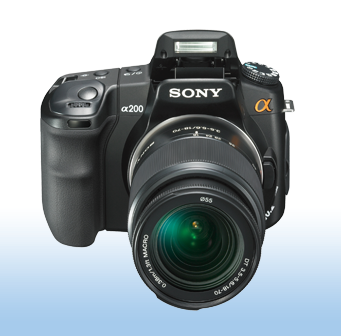 The new 10-megapixel, $700 Sony A200 has shown up on the SonyStyle website, with full information.
The new 10-megapixel, $700 Sony A200 has shown up on the SonyStyle website, with full information.
__________________________
Mike (Thanks to Robert E.)
Posted on Thursday, 10 January 2008 at 07:41 AM | Permalink | Comments (8) | TrackBack (0)
People Are Doing Double-Takes, And Taking Action, As Web Snapshots Are Nabbed for Commercial Uses
By Monica Hesse, The Washington Post
The pug in the corner of the Saints-Eagles football telecast on Fox looked familiar to Tracey Gaughran-Perez.
 Not in the slobber-smile way that all pugs look familiar, but in the who else but me would dress their pug up in a bleeping Santa suit kind of familiar.
Not in the slobber-smile way that all pugs look familiar, but in the who else but me would dress their pug up in a bleeping Santa suit kind of familiar.
Gaughran-Perez logged on to http://www.sweetney.com, the personal blog where she'd uploaded a snapshot of her dog, then waited for the Fox pug—a sort of "Merry Christmas" icon—to appear again on TV.
Argh.
The pug was definitely Truman; the photo was definitely one she'd marked as "all rights reserved...."
READ ON at washingtonpost.com
__________________
Mike (Thanks to Bob Burnett)
Posted on Wednesday, 09 January 2008 at 02:42 PM | Permalink | Comments (19) | TrackBack (0)
By Ctein
Those of you with long memories may recall my two columns from a year back about the $10 keychain camera (here and here). It was a helluva lot of fun to use, but the nonstandard storage format was readable only on a limited number of computers, and the fact that photos were stored in RAM meant that I lost a high percentage of them due to dying batteries. And, let's face it, the picture quality was even less than marginal.
Six months back, Mike ran an item about the CatCam. When read the photographer's description of what he had done, I realized this was a keychain camera with a memory card slot! Of course, I had to buy one. Even at the lofty price of $25, it was more than worth it. I am now the proud owner of a VistaQuest VQ1005. I decided to go all the way and splurge for a maximum-sized memory card: a $10 512 MB SD card. I am nothing if not a big spender.
Above: The VistaQuest VQ1005 takes SD memory cards. The sliding cover protects the lens and the shutter release. Below: Ready for action, with the memory card inserted, the lens uncovered, and the nearly-useless viewfinder extended.
The size is similar to my previous keychain camera: The VQ1005's a few millimeters fatter, but it's slightly smaller in length and height. It answers many of my previous complaints. It uses standard digital camera storage format, so it looks just like a USB hard drive on your computer under any operating system that recognizes USB. No weird drivers needed. Insert an SD card into the slot and photos are automatically written to the card. When your batteries finally die (and they will die, believe me; just like the other camera, this one constantly keeps the RAM powered up) you don't lose any photos!
At standard resolution (which produces the best image quality on this camera) about 2000 photographs will fit on the memory card! As a result, the issue of whether to reformat or delete frames hasn't come up; I'm just leaving every photo on the card (and, of course, downloading them to my computer). I expect the camera to break before I fill the card.
Camera resolution is a whopping 1.3 megapixels. In other words, we're up to about cell phone quality. In my opinion, the pictures benefit from considerable massaging in Photoshop, especially the Shadow/Highlight tool (but just about every snapshot benefits from that fabulous tool).
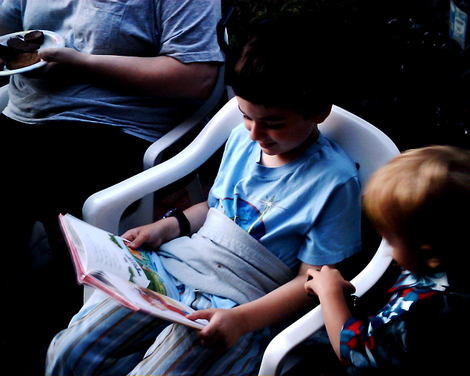
The "near" focus setting works best for photographing one or two
people. This is the photograph as it came directly from the camera.
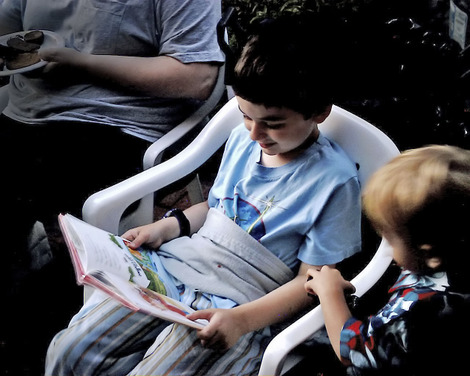
The quality is considerably better after some Photoshop work. Judicious
application of the Shadow/ Highlight tool, some sharpening with Focus
Magic, and some noise reduction makes a big difference!
The camera does not have the low-light capability of the other keychain camera; it'll work okay under bright indoor light, but that's its limit. On the other hand, it doesn't totally lose it in direct sunlight.
In fitting with this camera's fine quality standards, it actually has a lens with two focus positions—one setting for closeups of people and one for landscapes, according to the icons on the camera. The near focus setting seems to be about 3 ft. and the far focus setting at about 10 ft. But the "plane of focus" is anything but flat, as my last illustration clearly shows, so who knows?
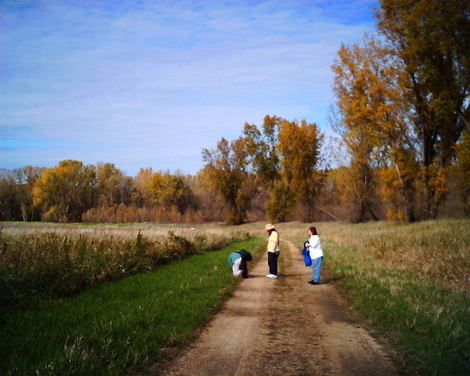
Where's the point of best focus at the "for" focus setting? Beats me!
Seems to depend on where you look in the photograph. Field flatness;
what's that?
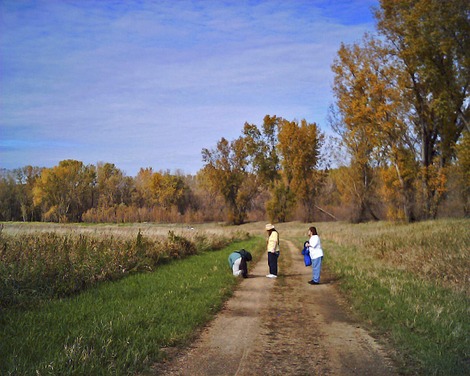
Same photo, post-Photoshop. Great art, fer shure!
I didn't find any stores that carry this camera on their shelves, but it's available online from several sources. Take my word for it: this is a must-have for any serious connoisseur of fine photography.
_________________________
Ctein
ADDENDUM: Here's an Amazon link for the camera. I got mine from CompUSA, but they're defunct, and I'm one of those anti-Walmart types, so Amazon's your best bet. —Ctein
Posted on Wednesday, 09 January 2008 at 08:37 AM in Ctein | Permalink | Comments (30) | TrackBack (0)
Mark Goldstein at PhotographyBlog has published his review of the Olympus E-3 this morning. I must say that I've been sorely tempted by the E-3 in the process of shopping for a new DSLR. I like its features and its practical advantages such as its physical toughness and waterproofing, and I've been very impressed with its image quality. (And I'm not convinced by arguments against the 4/3rds sensor size, as I will detail in a future column in Black & White Photography magazine).
Alas, I just can't get over the lack of prime lenses in the system, and I've decided I can't buy into the Olympus system for that reason. I'm a prime lens partisan but not a prime lens snob—I've enjoyed using a zoom on my Konica-Minolta 7D, and on the Contax Aria I had in the late '90s. But I require that at least one or two wide-normal semi-fast single-focal-length street-shooting/snapshooting lenses be available in a system as an option.
Were it not for this, I would buy an E-3. It's a beautifully designed and built camera.
Olympus E-3 review at Steve's Digicams
Olympus E-3 review at PhotoReview.com (Australia)
Olympus E-3 preview at Imaging-Resource
____________________
Mike
UPDATE: You can find my general argument in favor of primes here (although note that I'm not really anti-zoom much any more), and here is the reason I'm not particularly interested in the Leicasonic 25mm ƒ/1.4 (although I am kinda interested in it).
Posted on Wednesday, 09 January 2008 at 08:12 AM | Permalink | Comments (50) | TrackBack (0)
Oren turned me on to a lovely song over the weekend, Joseph Bates's taut, spare arrangement of Imogen Heap's eccentric, electro-spacey "Hide and Seek." The complete track plays automatically if you go to the Myspace page of Bates' group, Transit.
If you like it, you can download it if you go to "Download Hide & Seek! (view more)" under "Upcoming Shows." That leads you to a blog with a URL to the A-Cappella.com downloads page which you then have to sign up for. By the time payment is made and the various email exchanges carried out, the download opens in a browser window...we Mac people don't think in terms of "right clicking" but even I was able to figure out how to isolate the file and finally copy it into iTunes. I'm not saying all this was difficult, particularly, but...lots of steps.
The Transit version is a beautiful piece and well worth hearing at the Myspace page, at least.
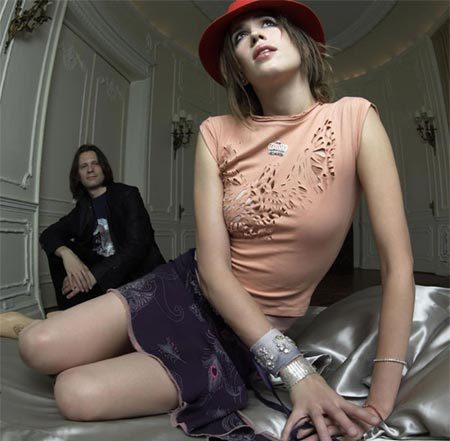
Imogen Heap with Guy Sigsworth
_________________
Mike (But don't thank me, thank O.G.)
Posted on Tuesday, 08 January 2008 at 08:58 AM | Permalink | Comments (7) | TrackBack (0)
Reviewed by Geoff Wittig
 Nazraeli Press,* 2007. Retail $75, Amazon U.S. $60.20
Nazraeli Press,* 2007. Retail $75, Amazon U.S. $60.20
Link to Amazon U.S., Amazon U.K.
, Amazon Canada
Flowers have to be one of the most photographed subjects imaginable. I mean, how can you not like flowers, right? Everyone with a camera is tempted to take a whack at them. I can recall pointing my brand-new Pentax 35mm SLR at my wife's day lilies nearly 20 years ago and burning through some rolls. When those K64 slides came back I was underwhelmed by the results. My wife glanced over my shoulder at the light box and muttered, "Maybe you should try birds or something." Other folks have obviously had more success. In the last two years "brand-name" photographers including Howard Schatz, Barbara Bordnick
and Joyce Tenneson
have all done books of flower images. Current fashion appears to favor close-ups of huge drooping blossoms, or sepia toned images of dried up and dying blooms. The books do seem to fly off the shelves, so there's obviously a market for them.
Given the ubiquitious, done-to-death nature of flower photos, it takes some work to do something creative. Scott Peck's gorgeous series of flowers frozen in ice is one unique effort. Tony Mendoza's new work, titled simply Flowers, is another. Mendoza is a Cuban-born photographer probably best known for Ernie, a book of photos of the cat he shared a loft with in NYC. Published in 1982, it acquired something of a cult following. The images are genuinely witty, in an Elliott Erwitt sort of way.
Flowers is a new direction for Mendoza. The introduction explains how he began photographing a community garden tended by his wife, finding that the zero incremental cost of digital exposures made it painless to experiment. The resulting book of images has a consistent style and æsthetic that kind of grew on me. I must confess that I find most flower photography saccharine to the point of nausea. Mendoza's work is different. The flowers are all photographed from ground level—i.e. from below—with relatively short focal lengths. All are lit with flash, most about a half stop to a stop "hotter" than the sky behind them. The resulting images are almost disorienting, sort of a "Land of the Giants" perspective where the occasional passing bumble bee looks the size of a beagle. Some of the flowers are clearly past their prime, others immaculate. The level of well-lit detail demonstrates how bizarre many plants are when you really study them closely.
As a physical object the book is impressive for its dimensions, 12.2 x17.6". The fifty plates are therefore large enough to have serious impact; the color and detail really hit the eye. Some care has obviously been taken in laying out the images; the color palette and tonality of facing pages harmonize perfectly. The only negative is a quirk of the printing process; the plates demonstrate bronzing when seen at a glare angle, though they look fine under normal illumination. This is a problem familiar to anyone who's ever tried printing on glossy paper with a pigment inkjet. Mendoza's witty introduction and afterward add a bit of perspective to the project.
If you love flowers and gardening, this book is worth a look for its unique take on the subject. It may inspire you to dust off your flash and look at your own backyard garden again. It also demonstrates once again the impact of a consistent body of work, perhaps inspiring folks to organize a portfolio of their own. And that's not a bad thing.
______________________
Geoff
*The website of Nazraeli Press, the publisher of Flowers, is well worth a look for those who are interested in fine art photography. They specialize in quirky titles, some of which you are very unlikely to see at your local Borders or Barnes & Noble. They also appear to spend little if anything on promoting their books, so you have to seek them out. Their backlist includes many books by such luminaries as Robert Adams, Michael Kenna, Todd Hiro and Kenro Izu.
Consider yourself warned, however: for bibliophiles it's like letting the horse loose in the grain bin. —G.W.
Posted on Tuesday, 08 January 2008 at 01:56 AM in Books | Permalink | Comments (11) | TrackBack (0)
In Memoriam: Herbert Keppler, 1925–2008
By Jason Schneider, Popular Photography
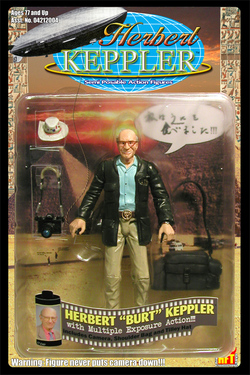 It is with profound sadness that we note the passing of Herbert Keppler, whose extraordinary brilliance and uncommon devotion in his lifelong work as an editor, publisher, mentor, and true and generous friend made him one of the most revered, respected, and beloved members of the photographic community.
It is with profound sadness that we note the passing of Herbert Keppler, whose extraordinary brilliance and uncommon devotion in his lifelong work as an editor, publisher, mentor, and true and generous friend made him one of the most revered, respected, and beloved members of the photographic community.
To state that Keppler was a positive force who helped advance the industry he loved so deeply, that he was a tireless advocate and thought-provoking guide for millions of amateur photographers all over the world, and that he was a practical camera design and marketing genius whose advice was eagerly sought and implemented by countless photographic manufacturers, distributors, and retailers, is merely to scratch the surface of his remarkable achievements. Knowing him was a privilege, and working with him an honor. He was a magnificent human being, not only in what he did, but also in who he was. We will sorely miss his puckish sense of humor, his joie de vivre, his unfailing loyalty, his kindness, and his staunch integrity. But most of all we will miss him—because we know we will not see his like again....
READ ON at popphoto.com
UPDATE: See also Mason Resnick's tribute at the Adorama News Desk.
-
Oscar Peterson, 1925–2007
By MJ
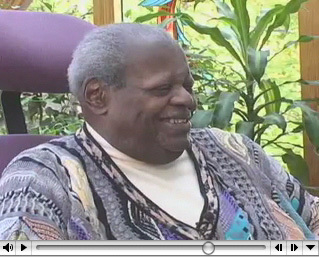 We lost Oscar Peterson over the holidays, who one pundit not unreasonably called "the greatest pianist since Liszt." Friends of the Luminous-Landscape know that Oscar was also a dedicated longtime photographer. You may have seen this already, but if you haven't, here's an absolutely delightful little movie MR recorded with Oscar in Toronto. Not crucial viewing for photographic content, but as I say, a delight. What a great guy—and what an honor that he was one of us where photography is concerned (he had many friends but few peers in music).
We lost Oscar Peterson over the holidays, who one pundit not unreasonably called "the greatest pianist since Liszt." Friends of the Luminous-Landscape know that Oscar was also a dedicated longtime photographer. You may have seen this already, but if you haven't, here's an absolutely delightful little movie MR recorded with Oscar in Toronto. Not crucial viewing for photographic content, but as I say, a delight. What a great guy—and what an honor that he was one of us where photography is concerned (he had many friends but few peers in music).
(Thanks to Mark Myers)
ADDENDUM: If you don't know Oscar Peterson's music, I envy you, because you've got a treat ahead of you. There are well over a hundred to choose from, but here is one of my own favorite Oscar Peterson albums. The sense of occasion in this life-affirming 2-disk live recording is infectious.
You can't go too far wrong no matter what you choose (unless, like one of my friends, you're allergic to string bands, in which case you'll have to avoid those). But there are many standouts. Paul Butzi reminded me that perhaps Peterson's best work were the albums he did with Count Basie—both on piano, no big band—the two men's polar opposite styles playing off each other amidst the obvious warmth and camraderie they felt for each other as friends. Those albums include:
Highly pleasurable and warmly musical, these titles show Oscar Peterson's ebullient good cheer, love of life, and scintillating musical virtuosity. Truly "desert island discs" that can be enjoyed again and again and again.
All of these are also available on emusic.com. and the Peterson/Basie albums are available on iTunes. —MJ
Posted on Sunday, 06 January 2008 at 04:51 PM | Permalink | Comments (11) | TrackBack (0)


